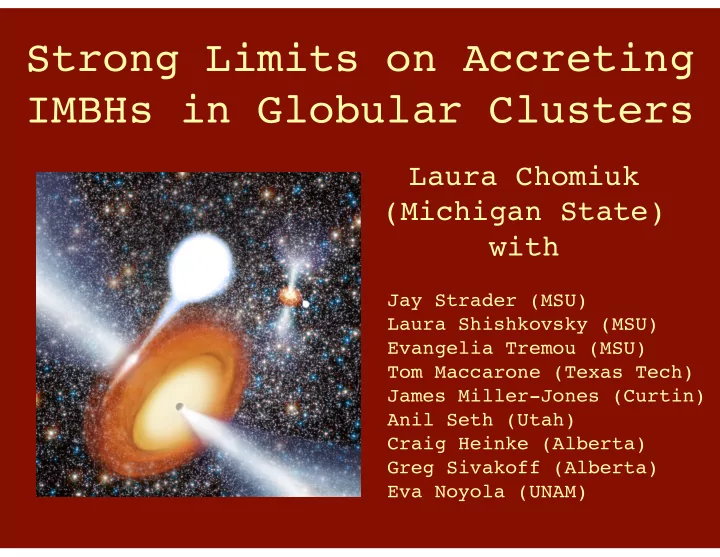

Strong Limits on Accreting IMBHs in Globular Clusters Laura Chomiuk (Michigan State) with Jay Strader (MSU) Laura Shishkovsky (MSU) Evangelia Tremou (MSU) Tom Maccarone (Texas Tech) James Miller-Jones (Curtin) Anil Seth (Utah) Craig Heinke (Alberta) Greg Sivakoff (Alberta) Eva Noyola (UNAM)
Expanding the sample of GCs with deep radio observations M15 NGC 6352 M62 M22 M5 M4 M28 47 Tuc NGC 3201 M10 M19 Terzan 5 M55 NGC 6712
Selecting clusters for likelihood of detecting IMBHs and stellar-mass BHs: Massive & Nearby *or* Really massive To be observed Yes, BH candidates No BH candidates
Expansion Approved! 280 Hours on Jansky VLA: 560 Hours on ATCA: 28 GCs (Dec > -35 deg), 26 Southern GCs, each reaching sensitivity each reaching sensitivity 1 σ = 1.5 μ Jy 1 σ = 3.5 μ Jy
Spanning a range of cluster properties
Searching for IMBHs with the “Fundamental Plane” of BH activity Merloni et al. 2003 valid in low/hard state L r ~ L x0.6
Predicting radio emission from IMBHs 1. Globular clusters have gas from giants 2. Some gas will accrete onto IMBH 3. Accretion will produce X-ray and radio emission with some efficiency
Predicting radio emission from IMBHs (i) ICM density: 0.2 cm -3 (ii) Accretion rate: 3% of Bondi (iii) efficiency: (not 0.1) (iv) (v) IMBH is on fundamental plane formalism: Maccarone (2004), Maccarone & Servillat (2008), Strader et al (2012)
Predicting radio emission from IMBHs: Typical Numbers Accretion rate is 0.1% of wind from a single red giant.
Predicting radio emission from IMBHs: Typical Numbers Accretion rate is 0.1% of wind from a single red giant. Radiative efficiency comparable to Sgr A*.
IMBH Non-detections in all GCs (16, to date) Strader et al (2012) M BH <~ 980 M ! M BH <~ 730 M ! M BH <~ 360 M ! Ter 5 M62
X-ray observations place similar limits. ω Cen (Haggard et al. 2013) 291 ks of Chandra time At center: < 1.6x10 30 erg/s M BH < 4x10 3 M ☉
But radio observations are more efficient. 7 μ Jy radio (8 ks on VLA) or (36 ks on ATCA) *equivalent to* 1.6x10 30 erg/s X-ray (291 ks on Chandra )
Strong Limits on IMBHs in GCs (16, to date) (Distance matters)
IMBHs aren’t so massive. *or* 1) ICM density Accretion 2) Fraction of Bondi is very 3) Radiative efficiency: inefficient (Maccarone 2003). Requiring continuity es ϵ = 0 . 1 (( ˙ M/ ˙ M edd ) / 0 . 02) . assume that ˙ is given by 3%
Strong Limits on IMBHs in GCs (16, to date)
A clever strategy for expanding IMBH searches Wrobel, Miller-Jones & Nyland in prep 5 minute stack 10 hour single M22 NGC 1023 Stack of 245 GCs in NGC 1023 (11 Mpc) rms ~ 1.2 μ Jy/beam in just 5 minutes on source!
A clever strategy for expanding IMBH searches Wrobel, Miller-Jones & Nyland in prep 5 minute stack 10 hour single 10 hour stack M22 NGC 1023 Stack of 245 GCs in NGC 1023 (11 Mpc) rms ~ 1.2 μ Jy/beam in just 5 minutes on source!
Future stacks of MW GCs will give deepest limits. Survey Stack ‹❯ ≲ 300 M ☉ ›❰ at ‹❯ 7 kpc ›❰ Stay Tuned!
Recommend
More recommend